After the opening 18 games of this season in the Austrian Bundesliga, Austria Vienna showed until now quite disappointing performances as they sit in the seventh position. If they still sit in this position after the first 22 games of this season, they won’t be in the playoff for the championship, but in the relegation group as the first six teams are in the group which will fight for the title.
Considering that Austria Vienna are usually one of the best teams in Austria, it’s quite a bad campaign for them and they just scored 28 goals in the first 18 games of the season. However, the most positive aspect of their season is the striker Christoph Monschein as he scored 15 goals and made five assists. In light of this, he has 18 scorer points while his team scored 28 goals. Just these numbers show how important Monschein is for his squad.
In this tactical analysis in the form of a scout report, we will look at the abilities of Monschein and why he is so important for Austria Vienna’s tactics and his team in general.
Positioning and movement
Austria Vienna used in this season different systems. Their coach Christian Ilzer lined his team up in a 4-2-3-1, 5-3-2, 3-4-3 and also sometimes in a 4-3-1-2. So, we see that they used different formations and also sometimes just played with one single centre-forward while in other games the had two strikers upfront. Monschein was in every single match of the 18 league games in this season part of the starting eleven what already shows that he’s clearly the first-choice striker of his Austrian coach.
The Austrian forward doesn’t like to just stay in the centre on the height of the opposing defence and wait for crosses and through passes, but often drifts to the outside or drops a bit deeper as we’ll see in this analysis. This can be perfectly seen his heatmap for the opening 18 league games of this Austrian Bundesliga season. It gets visible that Monschein often stays in the middle up front but doesn’t permanently stay there during the game.

Since as a centre-forward the Austrian often faces a centre-back who man-marks him, he sometimes likes to position in the wide-areas since there he has a bit more free space around him. However, he just positions on the wing when one of his teammates (either the second striker or the offensive midfielder) occupies the central area upfront. In the example below, the number 10 Alexander Grünwald is positioned in the centre what allows Monschein to position in the left wide-area where he has the free space to receive a good pass from the defensive midfielder Thomas Ebner.
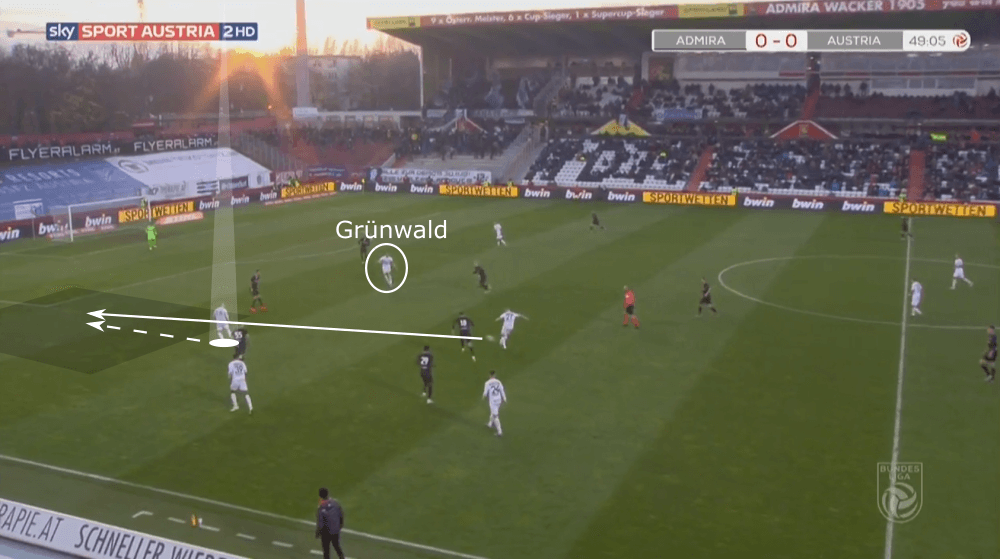
In the situation above and also in the following one, the Austrian forward tries to utilize his acceleration and pace. He stands at 5’10” what is an average height and is quite fast. He tries to make use of his pace whenever he looks for free spaces and provide an option for a through pass. His intelligent movement at which we’ll look later once more in this tactical analysis, combined with his physical abilities makes it sometimes really hard for the opposing players to defend against him.
In the shot below we can see how he once more searched for a free space and found it. This time it was in the centre and as the defender had to step out to get into the defensive duel with Austria Vienna’s Dominik Fitz, the 20-years-old midfielder found Monschein with a simple pass who then was in a one-on-one situation with the goalkeeper of Hartberg.
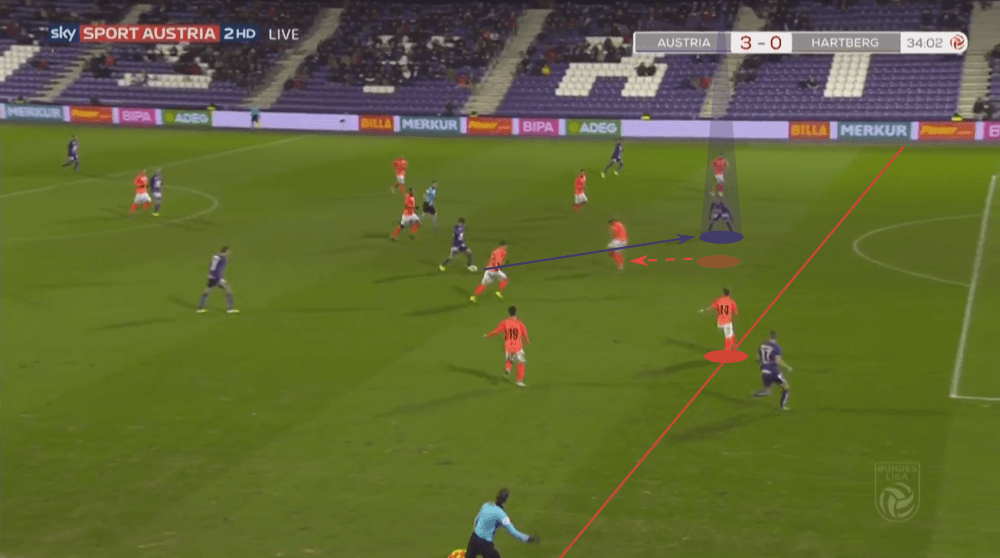
Getting involved
Nowadays, centre-forwards don’t just have the task to score goals, but also often should get involved in the build-up of their team to support the deeper positioned players in progressing the ball up the pitch. Roberto Firmino of the current UEFA Champions League champions Liverpool is surely one of the most famous examples for this development as permanently drops deeper to take part in the build-up of the Reds.
Monschein isn’t a striker who permanently drops deeper to collect the ball and then dribbles or passes. His stats also show that as he plays 14.26 passes per game and starts 4.84 dribbles per game. His success rates also aren’t really outstanding with the values 58.8% (passing) and 38.2% (dribbles). However, he knows that he’s not on average strong on the ball and due to that he tries to support his teammates by providing a passing option, but still focuses on moving in the higher lines to receive through passes and be present in the penalty box.
So, as we can see in the example below, he supports his teammates in dropping deeper and give them an option when there are all other players of Austria Vienna marked, but after that, he instantly moved back forward to occupy the centre again.
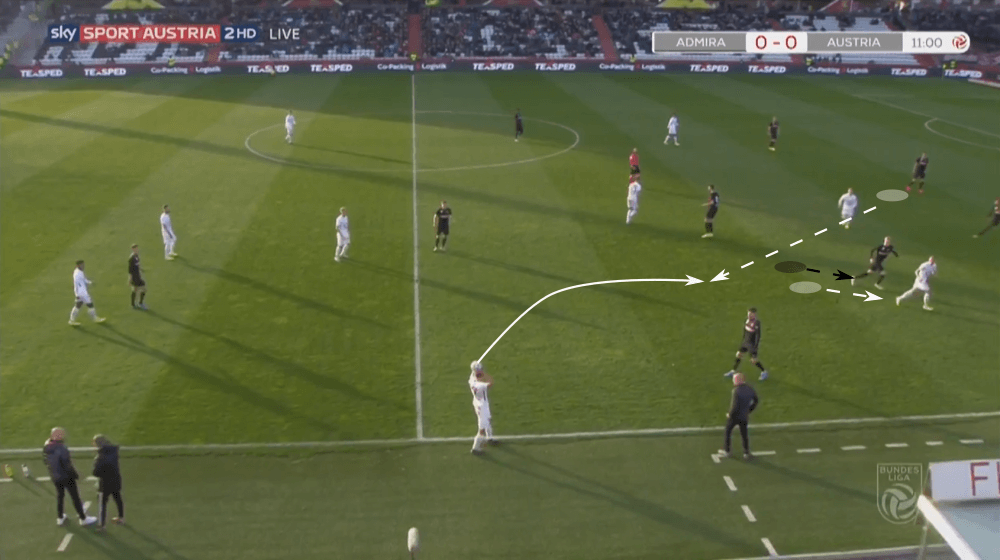
Also, Monschein has quite a good feeling for when he can drop deeper and receive a pass in the space in front of the defence of the opposition and when he should stay higher. In both examples above and below the player who is on the ball has no real option to pass the ball (or throw it in). Due to that, the movement of the Austrian forward is necessary to stay in possession and continue the build-up. In the shot below, he detects the space in front of him and moves into that free room to receive the ball and then use two touches to play a safe pass to the deeper positioned Grünwald (#10). In both situations, after he completed his action, he moved back into the centre upfront to occupy the pace in the middle in the higher line.
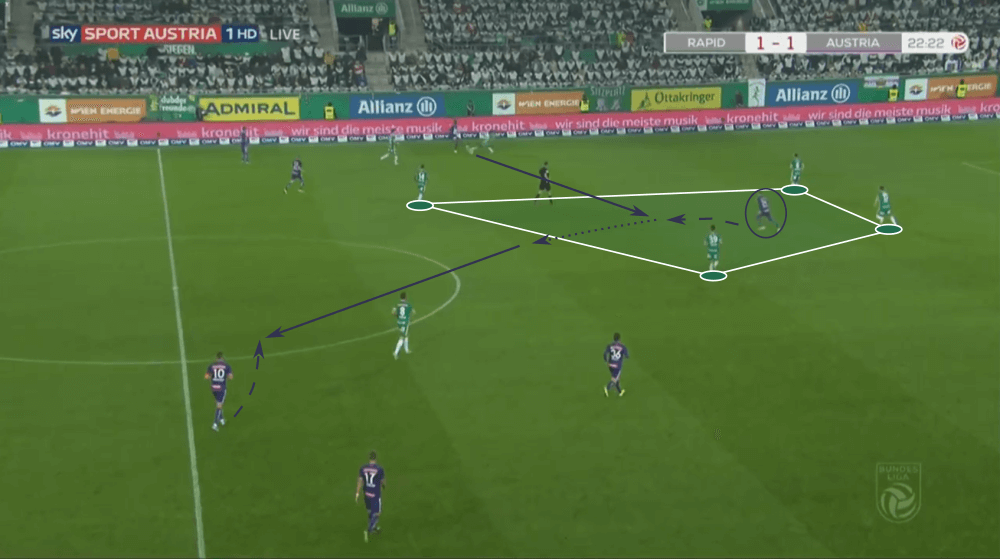
As already mentioned earlier in this scout report, Austria Vienna used in this season systems with two strikers and also sometimes just played with Monschein alone in the centre upfront. This aspect influenced the style of play of the Austrian striker quite a bit as it meant that he could position in one of the two wide-areas while the centre was still occupied by his partner. In the situations below, he sprinted back to the central space as soon as he passed the ball to one of his teammates, so Austria Vienna have one man in the centre in the higher line. In both these games, Monschein was the single man upfront in Vienna’s formation.
However, when he had a partner upfront he drifted more often to the outside as we can see in the situation below. In this game, Alon Turgeman was the second forward beside the Austrian and Monschein played in this situation a perfect long pass to hi striking partner as we can see in the shot below.
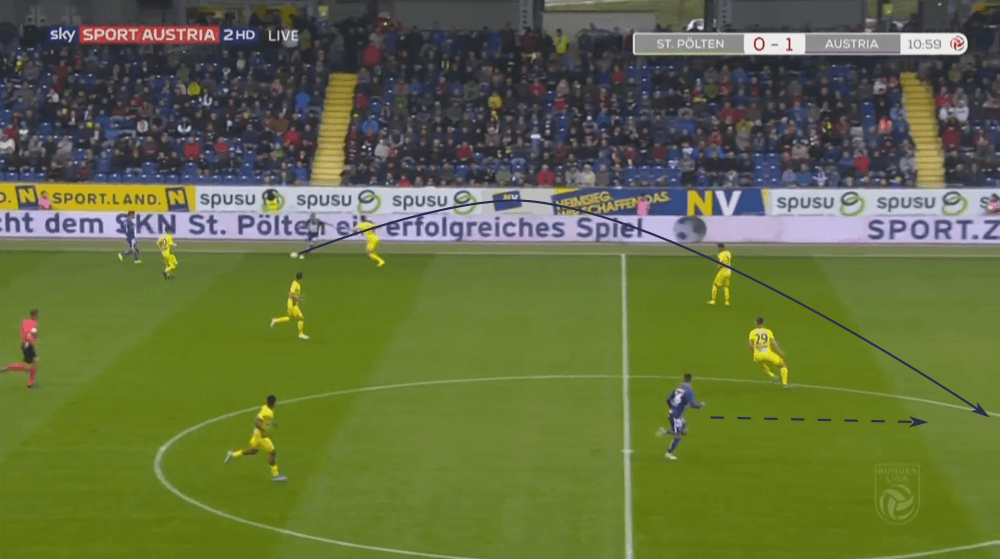
Dangerous and efficient in front of the goal
As we already saw in this tactical analysis, Monschein is a player who tries to support his teammates during the build-up if really necessary, but then tries to go back into the space up front where he can receive through passes and crosses. And since he scored in this season 13 goals in 18 games in the Austrian Bundesliga, he’s clearly among the best strikers in the highest division of Austria. Only Shon Weissman (Wolfsberger AC), Erling Braut Haaland (RB Salzburg, but now Borussia Dortmund) and Patson Daka scored more goals in this season so far. Due to that, we’ll now look at his goalscoring abilities.
First of all, we’ll have a look at his positioning ahead of crosses and when the ball is played into the wide-areas respectively. Monschein scored in this season quite a lot of goals after crosses and as we’ll see within the next images, the main reason for that are his intelligent positionings and movements ahead of the crosses.
First of all, the Austrian forward permanently looks for three spaces as we already saw in this scout report. In deeper areas, he tries to open up passing lanes or provide an option for a through pass, but as soon as he’s in the penalty box, he instantly looks for a free space where he could receive a ball and convert it into a goal. Quite often, we then see how he positions between the two centre-backs of the opposition (when they play with a back four). In the shot below we can see that the right-winger Benedikt Pichler is on the wing on the ball as he looks for an option to cross the ball into the centre. Monschein is positioned cleverly in the free space between the defenders what allows him just seconds later to score the goal after the delivering by Pichler.
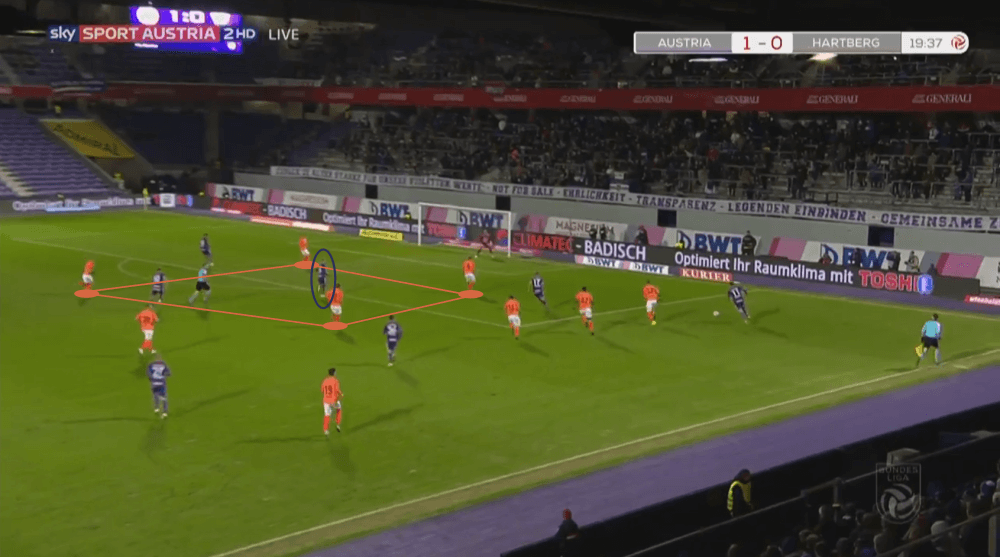
So, in the situation below we saw how the 27-years-old forward looked for a free space in the centre ahead of a cross. However, since Pichler was already near the end line, the defenders and also Monschein already were in their positions and there was not that much movement. Now, we look at another situation in which we can see how Monschein combines his pace with an intelligent run.
In the first shot below we can see that Dominik Prokop plays vertical pass along the touchline to Fitz. At this very moment, Monschein would be in front of the defender if he would continue his vertical run, but instead, he slows down and makes a diagonal movement away from the ball. Due to that, he’s just a second later behind the defender who doesn’t see him anymore. He starts to sprint again and runs past the defender who slowed down and due to that Monschein can easily convert the cross into a goal as he disappeared from the defender’s sight to the surprisingly run past him and score the goal. This situation perfectly shows once more that the intelligent movement of Monschein combined with his pace makes him an incredibly dangerous striker.
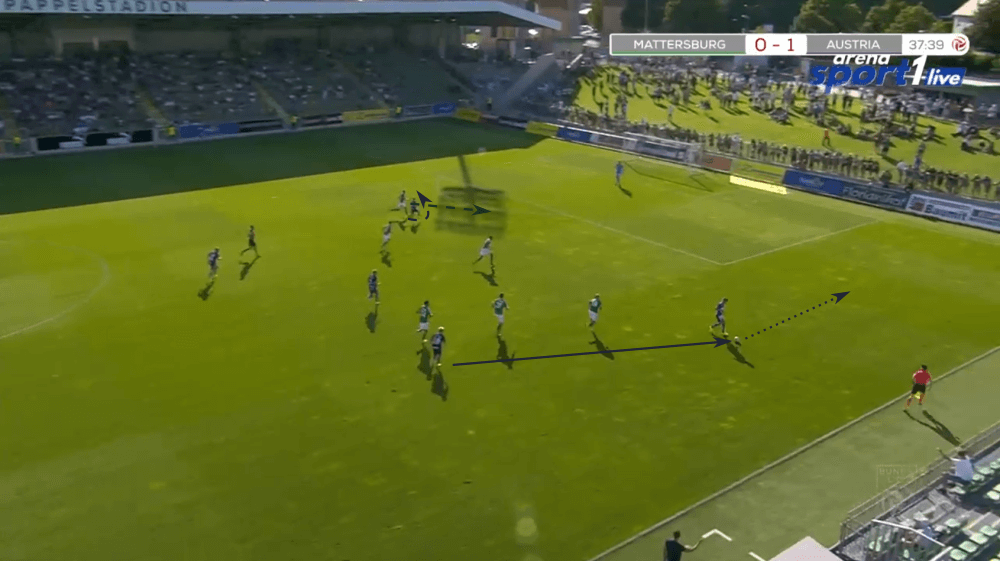
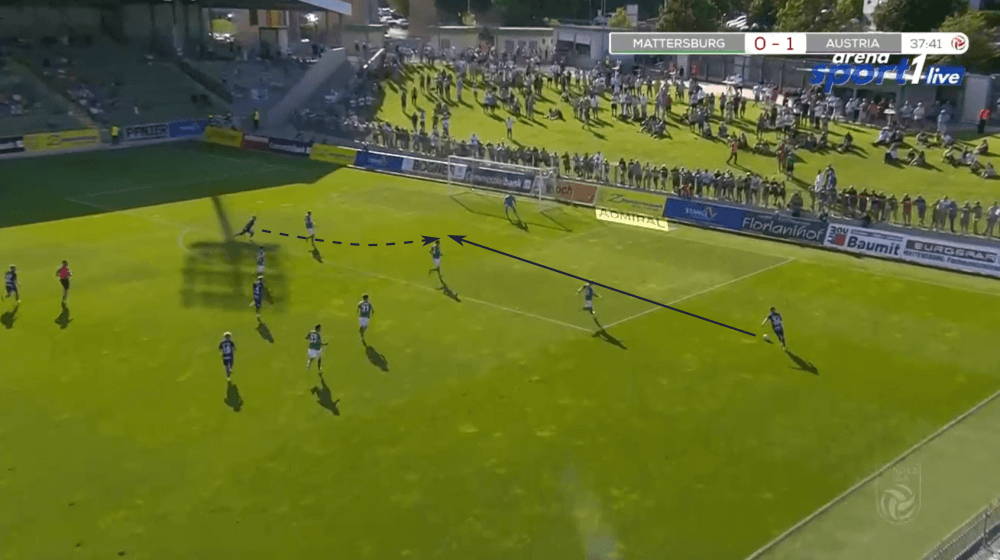
However, until now we primarily focused on Monschein’s positioning in deeper and higher areas as well when the ball is played out wide and how he tries to support his team during the build-up in some situations but we didn’t look at his decision-making in front of the goal and his shooting what are two central aspects of a successful striker.
So, basically, Monschein scores almost all his goals after crosses and rebounds (in both situations he makes use of his good positioning) or when he finds himself in a one-on-one situation against the goalkeeper. In the opening paragraph, I explained that Monschein often tries to receive through passes behind the last line of the opposition and now we’ll analyse how he acts in such situations.
First of all, the 27-years-old striker seems to stay in every situation cool and concentrated. Besides, he never just hammers the ball away, but looks what the keeper does and how big the distance is between the goalkeeper and himself to then find the right decision. The fact that he has an xG value of 0.43 per game, but actually scores 0.71 goals per 90 minutes. So, the stats also show that his conversion of chances into goals is really good.
So, he firstly looks how far away the keeper is away from him and if the distance is big enough to shoot, he looks for the right corner to place it. Usually, we see him often choose the simple but effective low shot into the far hand corner, but sometimes there is a better option as we can see in the example below. In this situation, the goalkeeper is already waiting for the low shot and due to that, he is already with his body position quite low. Due to that, Monschein just shoots hard underneath the bar to score the goal.
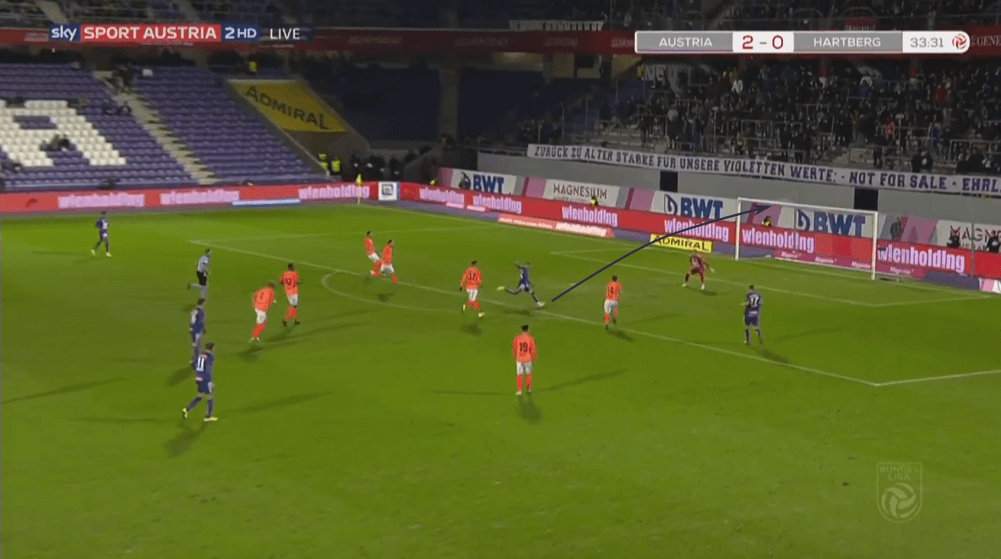
However, in some situations, it’s not possible for him to place the ball in one of the two corners since the keeper is already right in front of him. Also, in such moments he keeps a cool head and finds another way to score the goal. Either with lob shot (first image) or he plays the ball past the goalkeeper and also runs past him to then shot the ball into the empty goal (second image). So, his concentration and decision-making help Monschein massively in front of the goal.
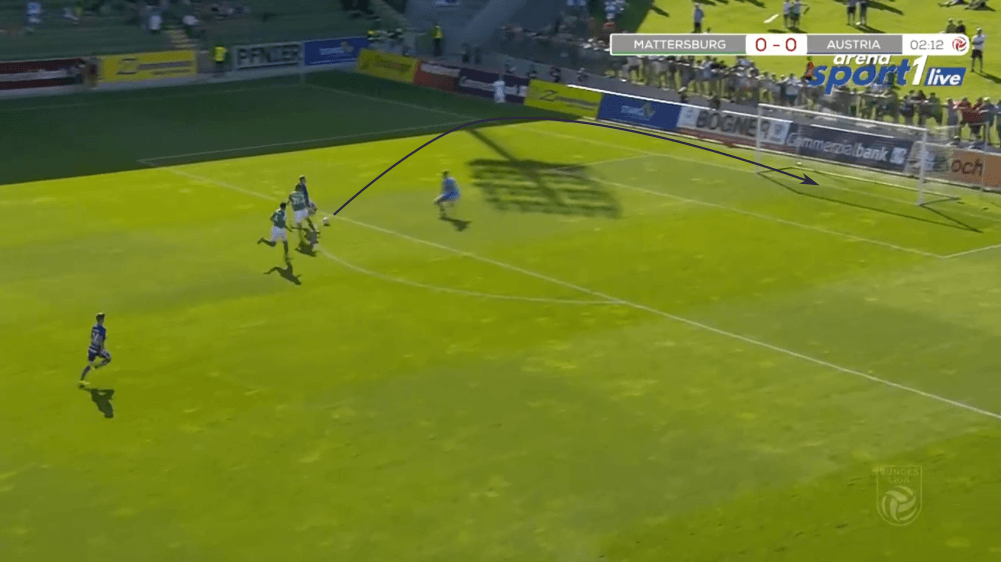
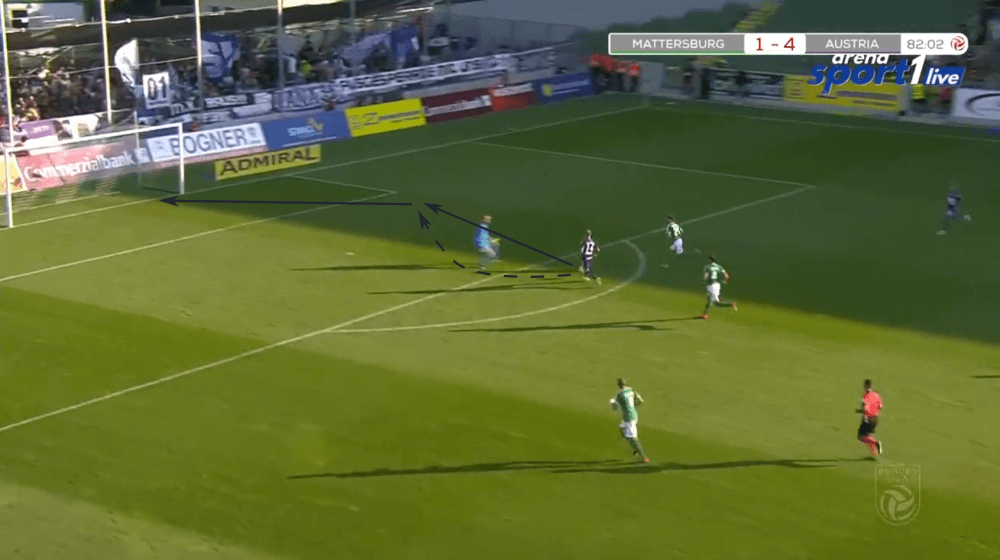
Conclusion
Basically, Monschein is neither a striker like Liverpool’s Firmino for example who often drops deeper to get involved in the build-up but is also not a striker like Jamie Vardy who just stays up front and waits for the through pass or cross to then score. The 27-years-old forward is somewhere in between these two types of strikers.
However, you have to note that Monschein is the Austrian with the most goals and also the most scoring points in the Austrian Bundesliga, but he still made no single appearance for the Austrian national team. Anyways, maybe he could be the perfect backup for Marko Arnautović during Euro 2020, but we’ll have to wait if Franco Foda will give him a chance.





Comments